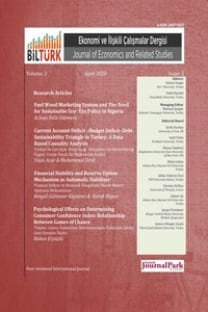The Relationship of Income Distribution in Turkey with Inflation & Per Capita Income
Ülkelerin gelişmişlik düzeyini ve refah durumunu anlatan en önemli göstergelerden bir tanesi de gelir dağılımıdır. Bu hususta önemli olan, hele ki ülkenin ekonomik, sosyal ve siyasal durumunun da etkin bir şekilde işlemesi düşünülüyorsa bu gelirin dengeli bir şekilde dağıtılması gerektiğidir. Bu çalışmanın amacı, teorik çerçevede Türkiye’nin gelir dağılımını inceleyerek 1980-2019 yıl aralığındaki kişi başına düşen milli gelir ve enflasyon değişkenlerinin gelir dağılımı ile ilişkisini Granger nedensellik ve Johansen eşbütünleşme analizi yardımıyla incelemektir. Elde edilen bulgular sonucunda, bir tane eşbütünleşik ilişki gözlemlenmiş ve gelir dağılımını gösteren gini katsayısından kişi başına düşen milli gelire doğru bir nedensellik bulunmuştur.
Anahtar Kelimeler:
gelir dağılımı, gini katsayısı, enflasyon
The Relationship of Income Distribution in Turkey with Inflation & Per Capita Income
One of the most important indicators describing the level of development and welfare of countries is the distribution of income. The important thing in this regard is that this income should be distributed in a balanced way, especially if the economic, social and political situation of the country is also considered to function effectively. The aim of this study is to discuss Turkey's place in the world in income distribution within the theoretical framework and the relationship between per capita income and inflation variables between the years 1980-2019 with income distribution with the help of Granger causality and Johansen cointegration analysis. As a result of the findings obtained, one cointegrated relationship was observed and a causality was found from the gini coefficient, which indicates the income distribution, to the per capita national income.
Keywords:
income distribution, gini coefficient, inflation,
___
- ALESİNA, A. & PEROTTİ, R. (1994). The Political Economy of Growth: A Critical Survey of The Recent Literature. The World Bank Economic Review, 351-371.
- ASTERİOU, D., HALL, S. G. (2007). Applied econometrics (A modern approach using Eviews and Microfit Revised Edition). New York: Palgrave Macmillan.
- COŞKUN C. A., İSTİKLAL Y. V., “Gelir Dağılımında Adalet(siz)lik ve Gelir Eşit(siz)liği: Terminoloji, Temel Kavramlar ve Ölçüm Yöntemleri”, Yoksullukla Mücadele Stratejileri, Ed. Coşkun Can Aktan, Ankara, Hak-İş Konfederasyonu Yayınları ,2002, s.19
- ÇELİK, A. (2004). AB Ülkeleri ve Türkiye’de Gelir Eşitsizliği: Piyasa Dağılımı–Yeniden Dağılım, Çalışma ve Toplum, Sayı: 3
- DALY, M. C., AMY, D. C., ve RICHARD V. B. (1997).“A New Look at the Distributional Effects of Economic Growth During the 1980s: A Comparative Study of the United States and Germany,” Economic Review.
- DİŞBUDAK, C. ve SÜSLÜ, B. (2007), “Türkiye’de Kişisel Gelir Dağılımını Belirleyen Makroekonomik Faktörler”, Ekonomik Yaklaşım, 18, 65, s.1-23.
- DOĞAN, C., TEK, M.(2007). Türkiye’de Gelir Dağılımının Toplanma Oranı Yöntemiyle Analizi. Ekonomik ve Sosyal Araştırmalar Dergisi, Cilt:3, Yıl:3, Sayı:2, 3:93-119.
- ENDERS, W. (2015). Applied Econometric TimeSeries (4th edition). USA: John Wiley &Sons, Inc.
- FURMAN, J. & STIGLITZ, J. E. (1998), “Economic Consequences of Income Inequality”, ” in Income Inequality Issues and Policy Options, a symposium sponsored by the Federal Reserve Bank of Kansas City, Jackson Hole, Wyoming, August 27-29.
- GUJARATI, D. N. (2003), Basic Econometrics, McGraw-Hill (Fourth Edition).
- HUANG, H-C R. (2004). A flexible nonlinear inference to the Kuznets hypothesis. Economics Letters, 289-296.
- KANBEROĞLU, Zafer ve ARVAS, Mehmet Akif (2014), “Finansal Kalkınma ve Gelir Eşitsizliği: Türkiye Örneği, 1980-2012”, Sosyoekonomi, 21, s.105-122.
- KUŞTEPELİ, Y., HALAÇ, U. (2004). Türkiye’de Genel Gelir Dağılımının Analizi ve İyileştirilmesi, Dokuz Eylül Üniversitesi Sosyal Bilimler Enstitüsü Dergisi, Cilt VI., Sayı 4, s.143-160.
- KUZNETS, S. (1955). Economic growth and income inequality. American Economic Review, 45, 1-28.
- LIST, J. A., & GALLET, C. A. (1999). The Kuznets curve: What happens after the ınverted‐u?. Review of Development Economics, 3(2), 200-206.
- ÖZ, S. (2017). Türkiye’de 1980 Sonrası Maliye Politikaları ile Gelir Dağılımı ve Sosyal Adalet Arasındaki İlişkiler, İstanbul Üniversitesi Çalışma Ekonomisi ve Endüstri İlişkileri Ana Bilim Dalı Doktora Tezi
- PEÇE, M. A., CEYHAN, M.S., AKPOLAT, A. (2016). Türkiye’de Gelir Dağılımının Ekonomik Büyümeye Etkisi Üzerine Ekonometrik Bir Analiz. International Journal of Cultural and Social Studies (IntJCSS).
- SCOTT, C.D. and J.A. LİTCHFİELD, (1994), “Inequality, Mobility and the Determinants of Income among the Rural Poor in Chile, 1968-1986”, London School of Economics, STICERD DERP DP number 53, March.
- SÖNMEZ, M. (1992). Türkiye’de Gelir Eşitsizliği, İstanbul, İletişim Yayınları.
- TRIBBLE, R. (1999). A restatement of the s‐curve hypothesis. Review of Development Economics, 3(2), 207-214.
- Yayın Aralığı: Yılda 4 Sayı
- Başlangıç: 2019
- Yayıncı: Fatih DEYNELİ
